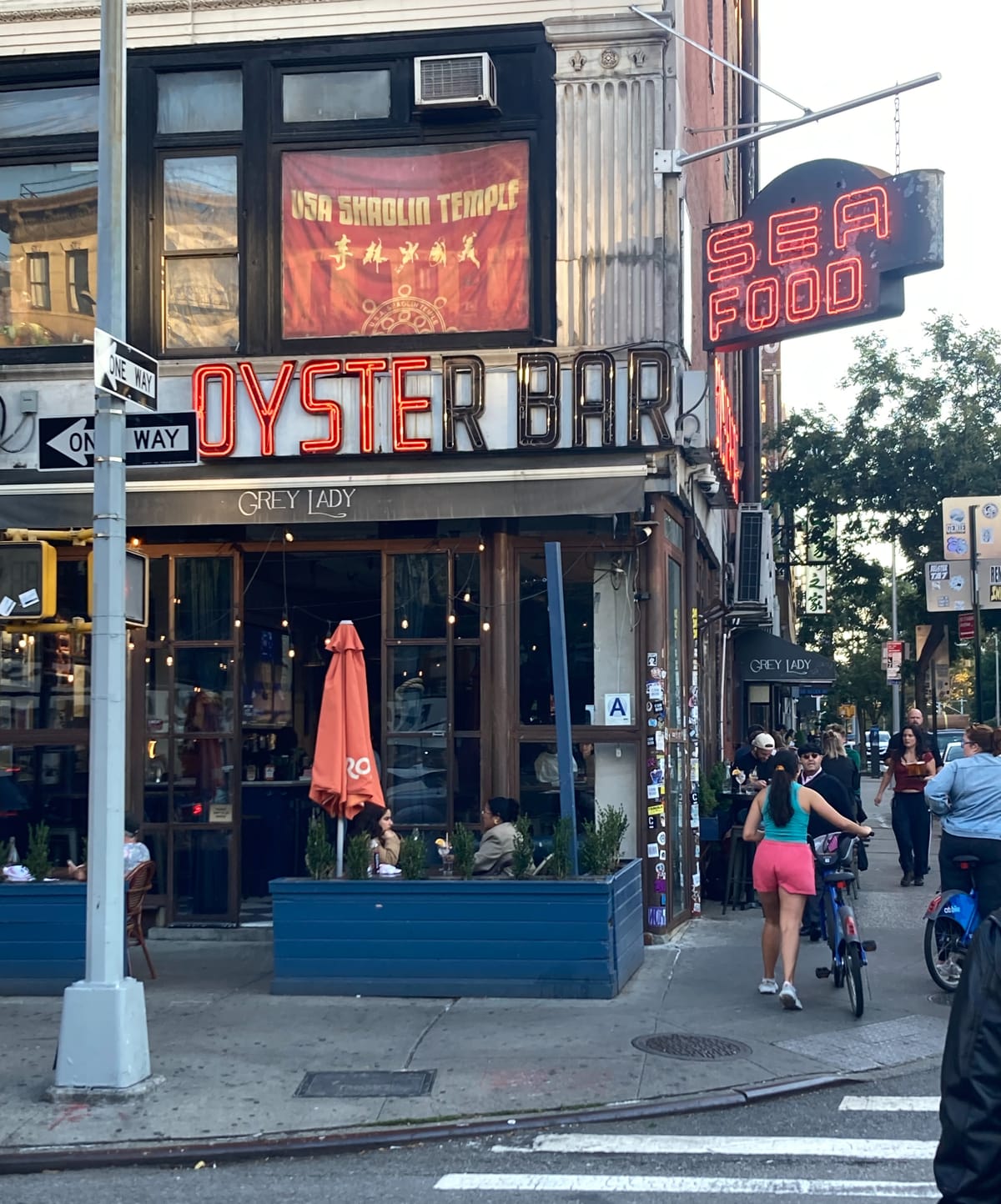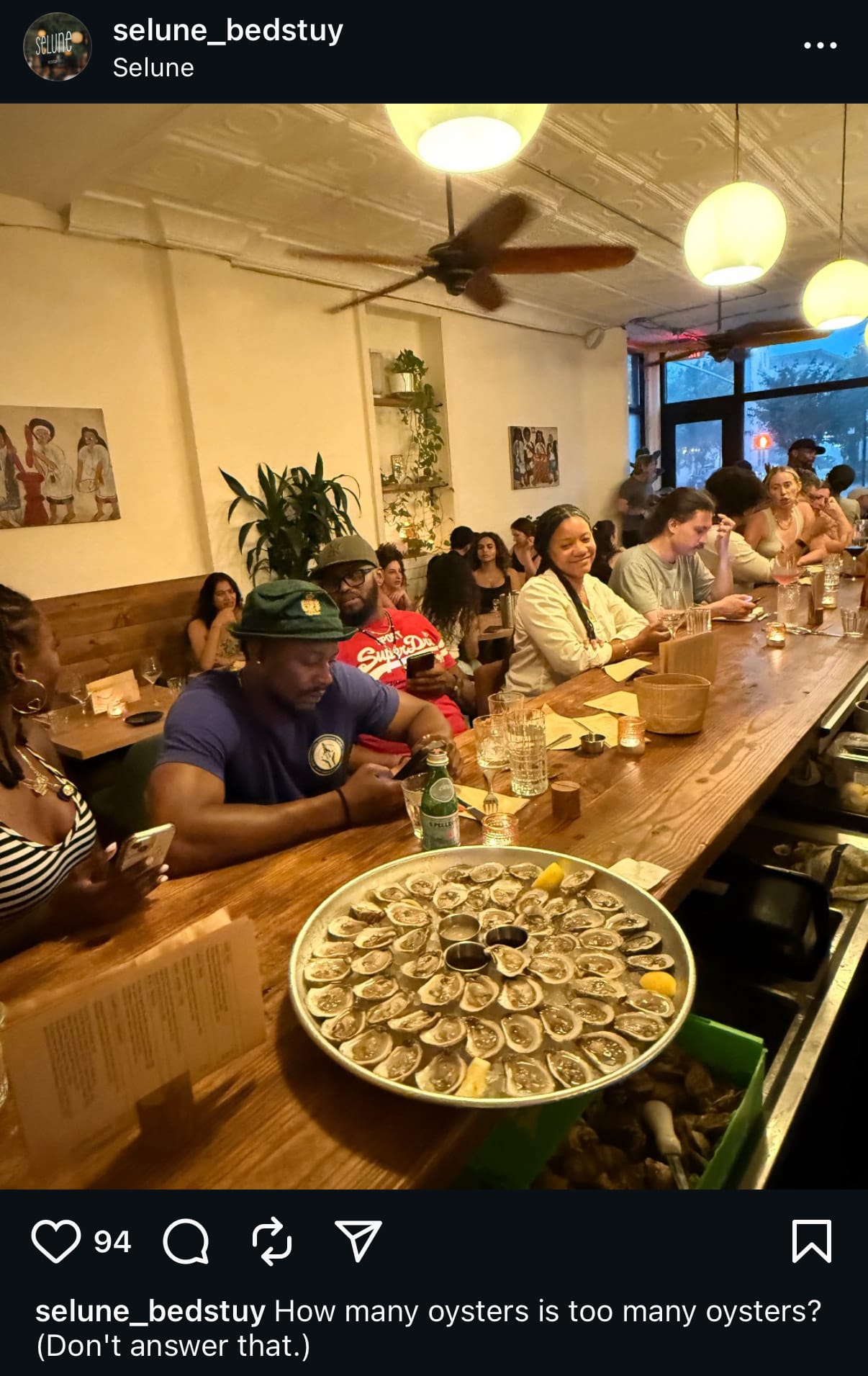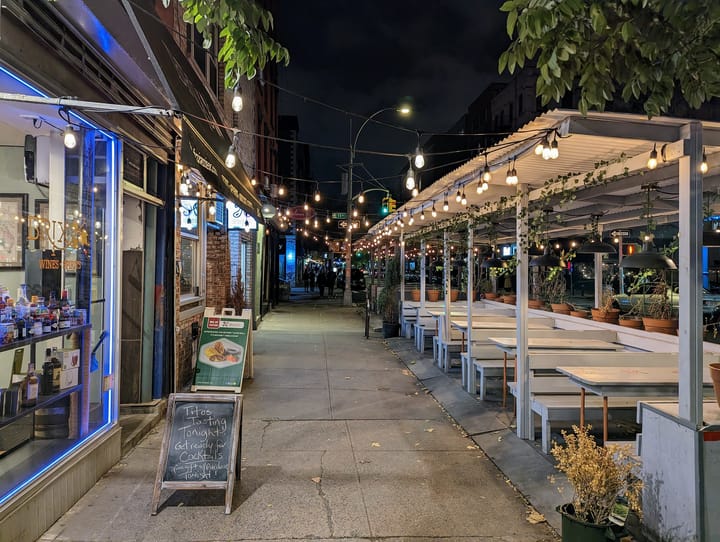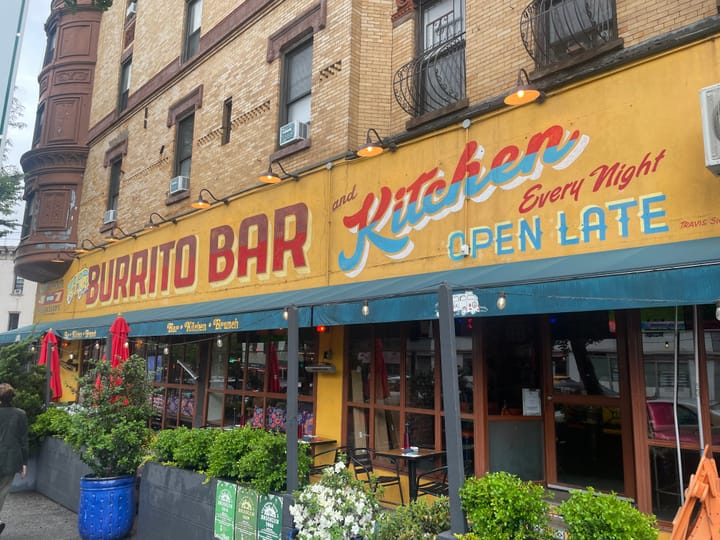Whatever happened to $1 oysters?
Rising prices have killed many $1 oyster happy hours, but we mapped out a few deals

On a recent unseasonably balmy Friday evening around 6pm, Orchard Street was bustling with happy hour drinkers and diners. The warm weather and the Lower East Side Open Streets initiative primed the block for outdoor sittin’ and schmoozin’, but there was another thing drawing New Yorkers to the streaterie at 14 Orchard St: Bar Belly’s nightly oyster happy hour. Patrons sipped discounted cocktails, wine and beers and slurped Barcats, a briny-creamy oyster variety from Chesapeake Bay, Virginia, for $1 a pop until 7pm.
It’s also the start of peak oyster eating season: October to December, when the oysters are plump and refreshed from a long summer of feeding and growing, and the water temps aren’t yet frigid enough to send them into hibernation, when they shut their shells for winter.
There was a time when $1 oyster happy hours were all the rage in New York City, as plentiful as picklebacks, $1 slice joints and DIY spaces. Now, Bar Belly is one of the few remaining hold-outs that still offers buck bivalves. Eater New York’s dollar oyster map includes 20 stand-outs – but, the catch is, it hasn’t been updated since 2019, and many entries on the list have either bumped their prices up to $1.50 or $2 each, or closed altogether.
When I reminisce about my old 1-buck-shuck go-to’s, a similar “In Memoriam” montage plays in my head. Littleneck (closed). Kittery (closed). Citroen (closed). Maison Premiere (no longer offers happy hour). Mermaid Inn (now up to $2 at happy hour). There are even the ones I never made it to, like Grand Central Oyster Bar’s dollar happy hour, which I learned about too late. It would have been so magical, for a deal-romanticizer and oyster lover like myself, to have gotten the chance to slurp on the cheap at such an iconic establishment.
To me, eating raw oysters on the half shell is one of those small joys in life. A pocket-sized taste of the sea, served up in a crooked, crescent shell. No one is quite like the other. There’s a ritual to the slurp: adding the accoutrement, tilting your head back, turning over your shell when it’s done, a plate of discards forming a clock. I grew up on them in New Orleans: oversized, wild Gulf oysters, briny enough to down with just a squeeze of lemon, or on a saltine doused in cocktail sauce. I recall a time when they went for $.25 during happy hour.
When I moved to Brooklyn in 2011, I expanded my oyster repertoire to varieties from the East and West Coast, from Blue Points to Kumamotos, which I found on the menu at Maison Premiere, often served with mignonette. I learned just enough about merroir — like wine terroir, but for the waters the oyster is sourced from — without getting precious, and would write down my favorite ones. The $1 price made it possible to indulge in a dozen every so often with friends, even when I was pretty broke.
Here's another deal for you: Support The Groove's independent, worker-owned service journalism for as little as $6 a month and you'll get access to the FOMO Calendar, bonus content, discounts and more!
What happened to oyster prices?
The thing is, selling oysters for $1 was always a “loss leader" for restaurants, a profit hit justified because it got patrons in the door, who would then make up the difference shelling out for drinks and other menu items (particularly since oysters don’t exactly fill you up). But since Covid, factors like inflation, climate change and even tariffs spiking wholesale oyster prices — along with the usual suspects like exorbitant restaurant rents and operating costs — have made the margin even more untenable, local restaurant owners told me.
“One of the harder decisions I’ve had to make over our time is raising the happy hour oyster price from one dollar to $1.50,” said Clark Riley, owner of Greenpoint’s Stowaway, one of my favorite spots for oysters and Southern food. “We maintained the dollar oyster as long as we could but due to rising operating costs (food/bev, utilities, insurance, rent, etc.) we have to see higher revenue across the board.”
The establishments that have kept the $1 oyster dream alive do so stubbornly, out of nostalgia for old traditions, or commitment to the bit.

“We're not making much of a profit on it, but it's a big crowd pleaser and so we do it for that reason alone,” Bar Belly owner Tom Mendes told The Groove. “We also have a history of selling oysters, so it just makes sense for us.”
Even if the math doesn’t add up, the demand is certainly there; Mendes told me that on a recent Friday evening, the restaurant sold 700 oysters between the hours of 4 and 7pm.
Essex, an oyster happy hour destination since 2000, still offers $1 oysters all night on Thursdays, but after Covid, upped their happy hour price the rest of the week to $1.50/each.
“Thursday night was always known as the night to go to Essex for oysters, and we have regulars who have been coming for years, so we kept that tradition going,” said Essex’s owner David Perlman. But Perlman estimates that the wholesale price of oysters has increased about 40% compared to pre-Covid. “We’re paying around $.75/oyster wholesale. On a $1 item, a 40% increase is a lot.”
The oyster has come a long way from its early heyday in the 1800s, when they were cheap and abundant in the New York harbor, selling for literal pennies out of street carts in the Financial District. The once ubiquitous peasant food is now a delicacy, along the lines of caviar or kobe beef – a special occasion splurge, at best.
The average person simply can’t justify shelling out $3-$5 per oyster, which is what they go for on most menus outside of happy hour. Sure, they’re tasty, but the sensation is over in about three seconds and you’re going to want at least a half dozen. This summer, I went on a boat cruise touring oyster farms on the Damariscotta River in Maine. Near the end of the ride, I treated myself to one (1) $3 river oyster, and just tried to … savor the moment.
If it weren’t for oyster happy hour, there are many city folk who might never try an oyster in their lifetime. That reality motivated Marc Lioussane, co-owner of natural wine bar Selune, to keep the bivalve price at $1 for happy hour.
“We wanted to be a place that everyone who lives in Bed-Stuy and beyond could come to and be able to have access to and enjoy delicious oysters and a glass of wine,” Lioussanne said.

“To be honest, the $1/oyster price point is certainly not a profitable one, but that is how important it was for us to do something that was about community and accessibility.”
Despite the higher prices, oyster happy hour is still kicking
Even though the $1 oyster heyday is mostly behind us, with $1.50 and $2 becoming the norm, oyster happy hour is still a flirty and thriving pastime in the city.
Last Friday evening, I wandered an oyster belt of packed seafood joints from 14th to Canal. You could easily fashion an oyster crawl and hit a dozen places in about a mile radius (depending on your stamina for slurping, but, I believe in you). A few noteworthy stops would be Upstate Craft Beer & Oysters on E. 6th Street and First Avenue, which offers a half dozen oysters and a craft beer for $13 (on the night I visited, they had an “Upstate’s Own” oyster, which the hostess told me is cultivated on North Fork, Long Island just for the bar).
A quick jaunt east to Alphabet City, The Wayland offers a dozen for $18 and nightly live music to boot. Grey Lady holds down $1 oyster happy hour every day, including all day Thursdays and Fridays, on the corner of Delancey and Allen streets. A little south of Delancey Street, you’ll hit The Ten Bells, a cute bistro offering tapas and $1.50/oyster happy hour (with an additional location in Bushwick), and finally, the aforementioned Bar Belly, down on Orchard Street almost at Canal.
Are there any tips or tricks to finding good oyster happy hours, you may be wondering? Well, you can read articles like this one of course; and we’ve put together a handy map of recommendations at $1.50 and under (embedded below). The Infatuation has a curated list as well, although theirs skews a bit pricier.
Beyond reading online, there are ways to tell with your own eyes if oysters are fresh and served with care. Off the bat, if the place is bustling at happy hour, hype aside, it’s probably a good sign that folks are returning satisfied by their slurping experience. At the table, the oysters should be served chilled, on a bed of ice. Each oyster should appear well-hydrated, with ample oyster liquor (the liquid that’s a mix of the oyster’s juices and seawater, and a sign of freshness) in the half-shell. It shouldn’t appear shriveled or discolored, and shouldn’t be gritty or sandy. It should smell briny, but not fishy.
If you’re going to partake in bivalves in NYC, a good thing to do is patronize an oyster joint that donates their shells to Billion Oyster Project, a local initiative to restore oyster reefs to the New York Harbor. Oyster shells help rebuild the reefs, providing habitat for marine life, including the growth of new oysters, which provide the vital service of filtering pollutants from the water and making it cleaner. The reefs also serve as buffers for effects of climate change, like storm damage, flooding and erosion. There are currently 61 NYC restaurants that partner with the Billion Oyster Project, donating shells each week for a good cause.
One more idea: Shuck ‘em if you got ‘em
Another hack? Shuck your own oysters. It takes a little startup investment to procure a quality shucking knife and gloves, and learn the ropes (here’s a handy how-to video from oyster expert Julie Qui) but it’s extremely satisfying to pry open oysters yourself and slurp ‘em down.
While it’s not as easy to find unshucked oysters in NYC compared to other seaside towns, and you may still pay more than a $1 each for them, it’s arguably more fun to do it yourself. You can find quality options at places like Greenpoint Fish & Lobster, Metropolitan Fish Market, Aqua Best Seafood Market or even Whole Foods. You order an icy sack, keep them cold and plan to eat them ASAP, while they’re fresh.
Serve them up back home, or you could pack a cooler and enjoy them at your go-to park or waterfront. The biggest thing to know, safety-wise: never eat an unshucked oyster that’s already open on its own. That means it has died and is not safe to eat.





Comments ()